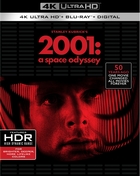BLU-RAY REVIEW

2001: A Space Odyssey 4K Ultra HD
Featured In Issue 240, June 2019
"2001: A Space Odyssey" is renowned Director Stanley Kubrick's groundbreaking science fiction epic and widely considered among the greatest films of the 20th century. The film is a compelling drama of man vs. machine. The film opens with a visit to our prehistoric ape-ancestry past, then leaps millennia into colonized space, and ultimately whisks astronaut Bowman (Dullea) into unchartered space. "Open the pod bay doors, HAL." Let an awesome journey unlike any other begin. (Gary Reber)
Special features include premium collectible packaging, commentary from Actors Keir Dullea and Gary Lockwood; nine featurettes: "The Making Of A Myth" (HD 43:08), "Standing On The Shoulders Of Kubrick: The Legacy Of 2001" (HD 21:25), "Vision Of A Future Passed: The Prophecy Of 2001" (HD 21:31), "What Is Out There?" (HD 20:42), "A Look Behind The Future" (SD 23:11), "2001: FX And Early Conceptual Artwork" (HD 09:33), "Look: Stanley Kubrick!" (HD 03:15) and an audio-only interview with Stanley Kubrick (November 27, 1966) (01:16:31); the original trailer; an 18-page premium booklet; art cards; and a Movies Anywhere digital copy code.
The 2.20:1 2160p HEVC/H.265 Ultra HD HDR10/Dolby Vision picture, reviewed on a Sony Bravia Z9D 4K Ultra HD HDR display, was photographed on Eastman film stock in Super Panavision 70, Todd-AO and Cinerama and sourced from a new 4K master Digital Intermediate using the 65 mm original camera negative. Filmmaker Christopher Nolan worked closely with the team at Warner Bros. Pictures throughout the mastering process. The initial release of the film had a run time of 161 minutes in 70 mm Cinerama roadshow format, which was edited to 142 minutes for the wide 35 mm theatrical release. As the film was produced in a large 70 mm film format with color by Technicolor® and Metrocolor, the wider color gamut exhibits a deeper color palette with superior resolution. Warner's Stuart Herriott, in a special feature segment, provides good insights into the restoration and the resulting re-mastering, which has been scanned and timed to directly match the original film release. Film grain is light and overall not a distraction. The opening, "The Dawn of Man" sequence, exhibits a desaturated look compared to the rest of the film, which looks appealingly saturated with a brighter overall appearance. The scene on the space station is super contrasty with white walls and floor and crimson-toned chairs. Reds are a dominant color. The color palette is robust with excellent luminance, yet fleshtones retain naturalness. The psychedelic climax is vividly hued with a wonderfully wide color gamut. HDR contrast is often striking, though, black levels do not exhibit the bold ink blacks that one would expect of outer space. Shadow delineation is excellent. Highlights are often very bright and effectively contrasted with the natural hues most often exhibited. At times edge enhancement appears, which detracts from the otherwise sharp lines in the imagery. Resolution is excellent throughout, with fine detail exhibited on the space station, the Discovery One spacecraft, and the launch pod, both with respect to exterior and interior appointments. Exteriors in space are effectively realistic. WOW! segments include 10:00 to 21:40, 33;39 to 36:12, 0:52 to 54:36, 01:12:08 to 01:18:48, 01:51:18 to 01:56:08, and 02:00:54 to 02:08:12. This is a classic Stanley Kurbrick film that is visually stunning in 4K Ultra HD HDR. Gary Reber)
The DTS-HD Master Audio™ 5.1-channel soundtrack is restored and re-mastered and sourced from the original 1968 six-track theatrical audio mix format. This is not a strong surround experience that is noticeably aggressive. Instead the surround channels provide a rather constant level of envelopment. Sound effects are at times strident sounding, such as the warning sounds aboard Discovery One. Atmospherics are generally good along width Foley sound effects, which are precisely executed. Bass is not particularly deep nor powerful. The orchestral/choral score is a mix of classical music orchestrations that sound distorted, as is to be expected of recordings made 50 years ago. The film opens in "blackness," with an intermission also in "blackness." Both sequences are filled with music. Dialogue is intelligible throughout with good spatial integration and directionalization. HAL's voicing is perfect with well-balanced integration. Overall, the soundtrack is remarkable considering it is very much dated, but lacks the dynamic strengths and bass extension, as well as surround aggressiveness of modern science fiction epics. Still, the soundtrack is well crafted and true to the silence of outer space in silent segments outside the spacecrafts. (Gary Reber)

 then "Add to Home Screen"
then "Add to Home Screen"